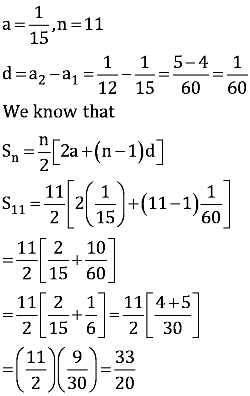Question 3:
In an AP
(i) Given a = 5, d = 3, an = 50, find n and Sn.
(ii) Given a = 7, a13 = 35, find d and S13.
(iii) Given a12 = 37, d = 3, find a and S12.
(iv) Given a3 = 15, S10 = 125, find d and a10.
(v) Given d = 5, S9 = 75, find a and a9.
(vi) Given a = 2, d = 8, Sn = 90, find n and an.
(vii) Given a = 8, an = 62, Sn = 210, find n and d.
(viii) Given an = 4, d = 2, Sn = − 14, find n and a.
(ix) Given a = 3, n = 8, S = 192, find d.
(x)Given l = 28, S = 144 and there are total 9 terms. Find a.
Answer:
(i) Given that, a = 5, d = 3, an = 50
As an = a + (n − 1)d,
∴ 50 = 5 + (n − 1)3
45 = (n − 1)3
15 = n − 1
n = 16

(ii) Given that, a = 7, a13 = 35
As an = a + (n − 1) d,
∴ a13 = a + (13 − 1) d
35 = 7 + 12 d
35 − 7 = 12d
28 = 12d

(iii)Given that, a12 = 37, d = 3
As an = a + (n − 1)d,
a12 = a + (12 − 1)3
37 = a + 33
a = 4

(iv) Given that, a3 = 15, S10 = 125
As an = a + (n − 1)d,
a3 = a + (3 − 1)d
15 = a + 2d (i)

On multiplying equation (1) by 2, we obtain
30 = 2a + 4d (iii)
On subtracting equation (iii) from (ii), we obtain
−5 = 5d
d = −1
From equation (i),
15 = a + 2(−1)
15 = a − 2
a = 17
a10 = a + (10 − 1)d
a10 = 17 + (9) (−1)
a10 = 17 − 9 = 8
(v)Given that, d = 5, S9 = 75

(vi) Given that, a = 2, d = 8, Sn = 90

90 = n [2 + (n − 1)4]
90 = n [2 + 4n − 4]
90 = n (4n − 2) = 4n2 − 2n
4n2 − 2n − 90 = 0
4n2 − 20n + 18n − 90 = 0
4n (n − 5) + 18 (n − 5) = 0
(n − 5) (4n + 18) = 0
Either n − 5 = 0 or 4n + 18 = 0
n = 5 or n =−(18/4) = −9/2
However, n can neither be negative nor fractional.
Therefore, n = 5
an = a + (n − 1)d
a5 = 2 + (5 − 1)8
= 2 + (4) (8)
= 2 + 32 = 34
(vii) Given that, a = 8, an = 62, Sn = 210

n = 6
an = a + (n − 1)d
62 = 8 + (6 − 1)d
62 − 8 = 5d
54 = 5d
d = 54/5
(viii) Given that, an = 4, d = 2, Sn = −14
an = a + (n − 1)d
4 = a + (n − 1)2
4 = a + 2n − 2
a + 2n = 6
a = 6 − 2n (i)

−28 = n (a + 4)
−28 = n (6 − 2n + 4) {From equation (i)}
−28 = n (− 2n + 10)
−28 = − 2n2 + 10n
2n2 − 10n − 28 = 0
n2 − 5n −14 = 0
n2 − 7n + 2n − 14 = 0
n (n − 7) + 2(n − 7) = 0
(n − 7) (n + 2) = 0
Either n − 7 = 0 or n + 2 = 0
n = 7 or n = −2
However, n can neither be negative nor fractional.
Therefore, n = 7
From equation (i), we obtain
a = 6 − 2n
a = 6 − 2(7)
= 6 − 14
= −8
(ix)Given that, a = 3, n = 8, S = 192

192 = 4 [6 + 7d]
48 = 6 + 7d
42 = 7d
d = 6
(x)Given that, l = 28, S = 144 and there are total of 9 terms.








































